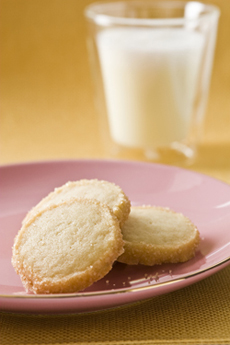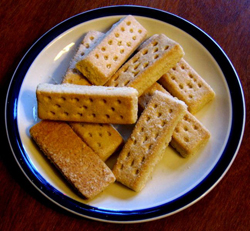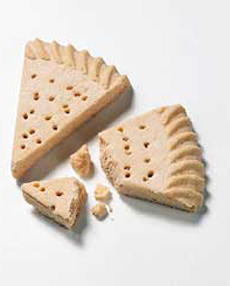
 Shortbread is elegant comfort food. Get the recipe for these classic cookies from pastry chef Larissa Raphael. Photo by Saidi Granados | THE NIBBLE. Shortbread is elegant comfort food. Get the recipe for these classic cookies from pastry chef Larissa Raphael. Photo by Saidi Granados | THE NIBBLE.
|
KAREN HOCHMAN is Editorial Director of THE NIBBLE.
|
|
March 2009
Last Updated January 2013 |
 |
The History of Shortbread Cookies
Originally From Scotland, Now A World Favorite
CAPSULE REPORT: Shortbread evolved from a medieval biscuit bread roll into a buttery cookie. Some versions are rustic, some are quite elegant. Here’s the shortbread history. This is Page 1 of a two-page article. Click on the black link below to visit Page 2.
Overview Of Shortbread Cookies
Shortbread is a type of cookie with a high butter content: The traditional recipe is one part sugar, two parts butter and three parts flour; some recipes use a 1:1:1 ratio, and there are variations in between (later recipes added eggs). It has been called the ancestor of all butter cookies. The original shortbreads were made with oatmeal; the more elegant white flour came later and lightened the cookie. The addition of rice flour gives shortbread a grainy, crumbly texture, while cornstarch (corn flour) gives it a more dense texture.
Shortbread originated in Scotland (where cookies are called biscuits) in medieval times. According to EnglishTeaStore.com, Scottish shortbread evolved from medieval biscuit bread, a twice-baked, enriched bread roll dusted with sugar and spices and hardened into a rusk. Eventually, butter was substituted for yeast, and shortbread was born.
In The Beginning
Shortbread may have been made as early as the 12th century, but its invention (or at least, the refinement to its current form) is often attributed to Mary, Queen of Scots (1542-1587) in the 16th century. She had a team of French chefs who had the time, labor and ingredients to perfect the recipes (you’ll read more about that below).
Shortbread recipes first appear in cookbooks of the time, although origination often precedes the first reference in print by a significant number of years. And alas, Queen Mary didn’t enjoy her shortbread with tea, nor did her cousin Queen Elizabeth I [1533-1603], because tea didn’t arrive in England until September of 1658.)
|
|

Shortbread fingers. Photo by Dave Souza | Wikimedia. |
It may be difficult for modern folks to imagine a world without a comforting hot cup of coffee, tea or hot chocolate, although herbal infusions have been around since as long as man could boil water, and there was hot cider plus hot spiced wine.
While shortbread is a famous accompaniment to tea (and of course, to coffee, milk and hot chocolate), the cookies are also served with wine and Champagne, and they are terrific accompaniments to ice cream, sorbet, puddings, fruit and other desserts.
The Name “Shortbread”
Shortbread may have been made as early as the 12th century, but its invention (or at least, the refinement to its current form) is often attributed to Mary, Queen of Scots (1542-1587) in the 16th century. She had a team of French chefs who had the time, labor and ingredients to perfect the recipes (you’ll read more about that below).
Shortbread recipes first appear in cookbooks of the time, although origination often precedes the first reference in print by a significant number of years. And alas, Queen Mary didn’t enjoy her shortbread with tea, nor did her cousin Queen Elizabeth I [1533-1603], because tea didn’t arrive in England until September of 1658.)
Why “Short” Bread? |
|

A triangle or “petticoat tail” was the original shortbread shape, baked in a round and scored. It was decorated with fork tines. Photo courtesy International.VisitScotland.com. |
There are two different explanations for the name of the cookie. Some sources cite the crumbly or “short” texture of the product. Others attribute the name to its high percentage of shortening, or butter (the word “shortening” refers to any fat).
Butteriness is an important quality in shortbread—so much so that in 1921 the British government legislated that a product called shortbread must get at least 51% of its fat from real butter. Outside of the U.K., however, there is no such requirement. Check the label to ensure yourself of an authentic shortbread experience. Hold out for 100% butter cookies.
Continue To Page 2: Shortbread Cookie Style
Go To The Article Index Above

|






